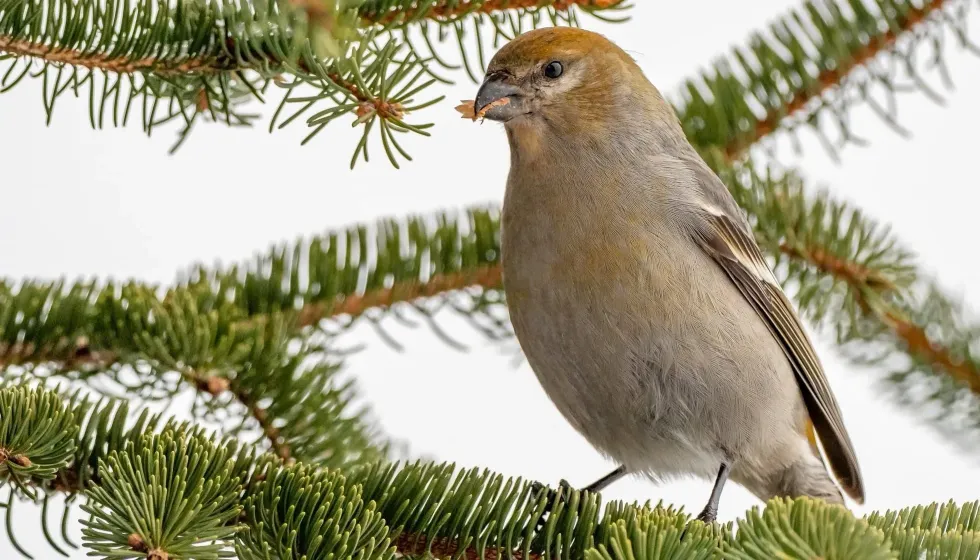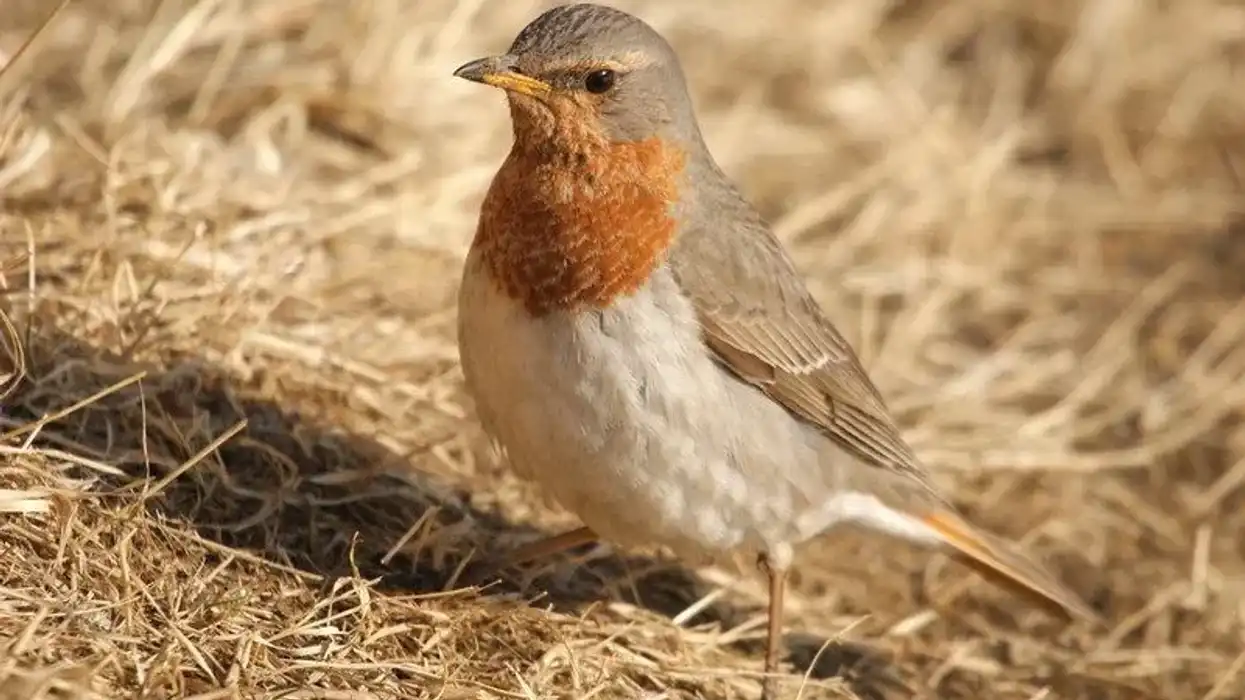Are you someone who loves watching the sight of the birds flying together in a group? Then here is some information about a rare bird species known as pine grosbeak.
The pine grosbeak is a bird that is a member of the true finch family. Pine grosbeaks are birds whose population is declining day-by-day due to different factors which are responsible for it. They also walk or hop along the ground when they search for fallen seeds or fruits.
They frequently visit feeders, especially during the winter season. They are known to be very beautiful in their appearance.
One of the most interesting pine grosbeak adaptations is the thick and stubby bill that allows it to easily crush seeds and nip off tree buds for its diet. Pine grosbeak diet comprises insects like grasshoppers, weevils, cutworms along with seeds, fruits, and buds.
Here are some of the most interesting aspects of pine grosbeak's description for your perusal. Afterward, do check our other articles on common kingfisher facts and gouldian finch facts as well.
Pine Grosbeak Interesting Facts
What type of animal is a pine grosbeak?
Pine grosbeak is a type of bird. Pine grosbeaks are birds that are large in size and are plump and are heavy-chested finch with a head that is round. Pine grosbeaks are the largest species of bird that fall under northern finches.
What class of animal does a pine grosbeak belong to?
Pine grosbeaks belong to the class of birds. Pine grosbeaks are the only species that come in the genus Pinicola. The species are known to be frugivores, especially in winter, which favors small fruits such as rowans.
How many pine grosbeaks are there in the world?
There is no accurate number for how many pine grosbeaks there are in the world as their numbers are declining and so the number of pine grosbeaks keeps changing on a daily basis.
Where does a pine grosbeak live?
Pine grosbeaks are known to live in the areas where there is open evergreen forest and also in mountainous regions and forests that are subalpine. These birds are also found in montane conifer forests of the Western United States and coastal rainforests of Alaska and British Columbia.
This bird species also lives in subarctic and boreal forests with deciduous trees across Eurasia and North America.
What is a pine grosbeak's habitat?
The pine grosbeak habitat comprises subarctic and boreal forests across Eurasia and North America. Their habitat also includes open evergreen forests with spruce, pine, mountainous regions, and subalpine forests, coastal rainforests.
During the winter, they prefer to use mountain ash, maple, and ash forests that have the presence of abundant seeds. Their nest is made up of twigs, moss, grass, lichens, and fur.
Who do pine grosbeaks live with?
Pine grosbeaks are monogamous in nature and stay in pairs before they arrive on the breeding grounds. The pine grosbeak nest is located in dense foliage and covered on a horizontal branch that is usually near the trunk of a tree or in a vertical fork.
How long does a pine grosbeak live?
The lifespan of a pine grosbeak is 9.5 years which also depends on certain factors such as a change in climate, diet, weather conditions, and other factors which determine the life of a pine grosbeak.
How do they reproduce?
The pine grosbeak breeding takes place in areas that are open spruce, fir, and also pine forests. During the winter breeding season, pine grosbeaks drop their feeders, especially in the East and outside of their normal range. Grosbeaks mate for life and are known to be monogamous.
After the mate has been found, the breeding season starts with the process of sexual mating. After laying the clutch of around 3-4 eggs, the female incubates the eggs for around two weeks.
Males bring food to the nest for the female during this period. During the breeding season, both males and females develop throat pouches enabling them to carry more food. Young birds leave the nest around 2-3 weeks after hatching.
What is their conservation status?
The conservation status of pine grosbeaks is at least concern at present. Though, their population is decreasing steadily based on certain factors which determine the life of the bird. These birds are fairly uncommon and breed in small pockets.
Pine Grosbeak Fun Facts
What do pine grosbeaks look like?
Male pine grosbeaks are reddish-pink and gray in color, whereas females and the young are gray in color with a hint of reddish-orange or yellow on the head and the rump. Pine grosbeaks have wings that are dark gray in color which is marked by two white wing bars, this is how you can identify them in flight.
They have dark eyes and pine grosbeaks eat a lot of plants.
How cute are they?
Pine grosbeaks are very cute and adorable in their appearance because of their color. They are very colorful with a redhead and rump with highlights of yellow and orange, red underparts, black wings with white wing bars.
People find the bird very adorable when they see it as it has beautiful texture as well as a color that makes it look even cuter.
How do they communicate?
Pine grosbeaks communicate by using different sounds that help them in communicating with their partner as well as with the other members. The pine grosbeak's song varies from a clear, loud carol full of trills to a soft and flowing warble.
How big is a pine grosbeak?
Pine Grosbeaks are very small in size as compared to the other big species of birds. This bird is very small and is not noticeable from a distance. They are around 7.9-10.1 in (20.06-25.6 cm) long and have a wingspan of around 13 in (33.02 cm).
How fast can a pine grosbeak fly?
There is no accurate information regarding how fast a pine grosbeak bird flies. Their speed of flying increases when they see their predator approaching them.
How much does a pine grosbeak weigh?
The pine grosbeak range of weight is maximized at 2 oz (0.05 kg). The weight differs according to the food that these finches eat.
What are the male and female names of the species?
There is no specific name for male and the female pine grosbeaks. They are known as male pine grosbeak and female pine grosbeak respectively.
What would you call a baby pine grosbeak?
There is no accurate name for the baby pine grosbeak. Therefore, they are called baby pine grosbeaks only.
What do they eat?
Pine grosbeaks eat insects, plants, buds, seeds, fruits from spruce, pine, juniper, birch, mountain ash, maple, box elder, blackberry, and many other food items. These North American birds also forage on the grounds or in the trees and nip on the fresh buds.
When it is winter, you can find pine grosbeaks eating grit and salt along the roadsides. Vegetable matter comprises almost 90% vegetable matter.
Are they dangerous?
No, pine grosbeaks are not dangerous in nature. These birds are not known to hurt or harm humans and prefer to live peacefully in their habitat.
Would they make a good pet?
Yes, pine grosbeaks make good pets and are also lovable in nature and are playful.
Did you know...
Pine grosbeaks were depicted in the 1986 series Canadian $1000 bill.
Pine grosbeaks are the largest of the north finches.
Pine grosbeaks love pine trees, hence the name pine grosbeak. The genus name Pinicola is Latin for pine dwellers.
The bill of the pine grosbeaks is heavy and black in color.
Pine grosbeaks are a rare species and come under the category of Least Concern with IUCN.
The tail of the pine grosbeak is slightly notched.
The pine grosbeak's adaptations
Pine grosbeaks are adapted to the environments that have open evergreen forests with spruce, pine, and other types of trees. They are also adapted to boreal forests and remain the residents near their breeding grounds.
Pine grosbeaks crush the seeds and nip off the tree buds and the needles with their thick and stubby bill.
Pine grosbeak vs purple finch
The purple finch is much smaller in size and also has a smaller bill when compared to pine grosbeaks. The call of a purple finch is short, whereas the call of a pine grosbeak is loud and long.
How to spot a pine grosbeak in flight
You can spot a pine grosbeak by its color. Their flight calls also vary differently. You can identify them by their size and shape, as well as they are large and plump. The color patterns make it easier to identify pine grosbeaks in flight.
Here at Kidadl, we have carefully created lots of interesting family-friendly animal facts for everyone to discover! For more relatable content, check out these purple finch facts, and skimmer facts.
You can even occupy yourself at home by drawing one on our Pine Grosbeak coloring pages.










